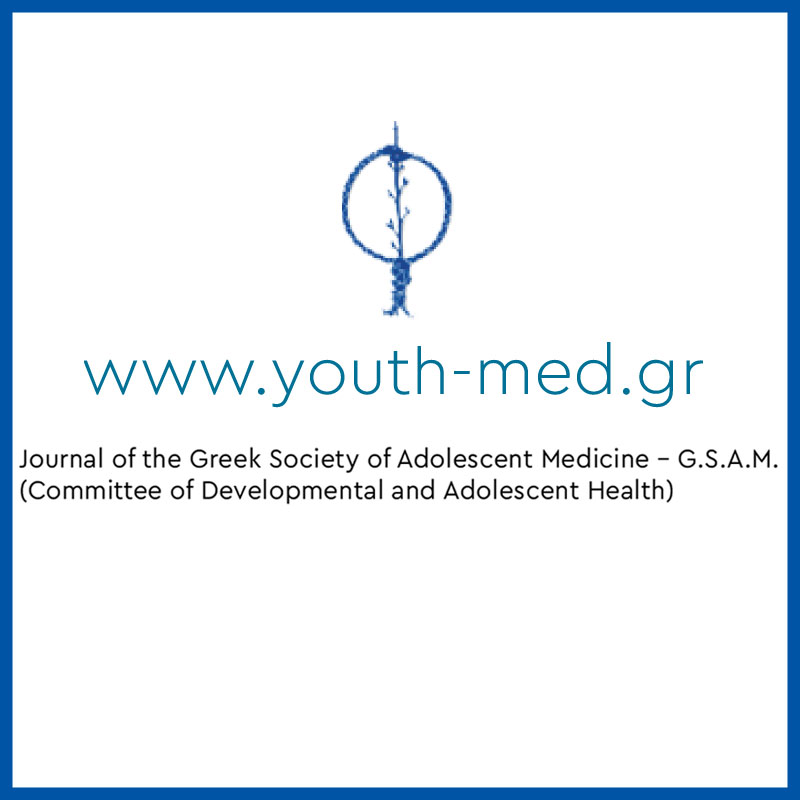Dysfunctional Internet Use by Adolescents in an Urban Environment: Α Case-Control Study
https://doi.org/10.54088/8ujmkll
Keywords:
Dysfunctional Internet Use; adolescents; risk factors; economic crisis.Abstract
Background: Dysfunctional internet use (DIU), or Internet Addiction Disorder, refers to excessive engagement with internet use which results in significant impairment of the individual’s ability to function in various fields of life, for an extended period of time. This multifactorial phenomenon concerns every society throughout the contemporary world. The present study examines personal, familial and social factors associated with DIU in adolescents who grew up in an urban environment during a period of severe economic crisis.
Materials and methods: DIU cases were matched 1:1 by age and gender to controls in a retrospective case-control study. The clinical sample consisted of adolescents who had been referred to the Adolescent Health Unit of the 2nd Department of Pediatrics, National and Kapodistrian University of Athens, and diagnosed as "Internet Addicted". Adolescents in the control group had been referred to the same Department for reasons other than DIU. Analysis was by conditional logistic regression with the presence of DIU as dependent variable.
Results: In multivariate analysis, family status (the adolescent not living with both parents) was a statistically significant risk factor for DIU (odds ratio 5.03, 95% confidence interval 1.20 – 21.0). Protective factors were participation in physical activity (odds ratio 0.05, 0.01 – 0.19) and antisocial behavior (odds ratio 0.10, 0.04 – 0.25).
Conclusions: Our findings indicate factors strongly associated with adolescent DIU in an urban setting during the economic crisis and complement other studies which have largely been based on self-report school surveys.
References
Kuss D, Griffiths M, Karila L, Billieux J. Internet addiction: A systematic review of epidemiological research for the last decade. Curr Pharm Des. 2014; 20(25): 4026-4052. doi: 10.2174/13816128113199990617
Cash H, Rae CD, Steel AH, Winkler A. Internet Addiction: A brief summary of research and practice. Curr Psychiatry Rev. 2012; 8(4): 292–298. DOI: 10.2174/157340012803520513
Weinstein A, Lejoyeux M. Internet addiction or excessive internet use. Am J Drug Alcohol Abuse 2010; 36(5): 277-283. doi: 10.3109/00952990.2010.491880.
Karacic S, Oreskovic S. Internet addiction through the phase of adolescence: A questionnaire study. JMIR Ment Health 2017; 4(2):e11. DOI: 10.2196/mental.5537
Franchina V, Vanden Abeele M, van Rooij A J, Lo Coco G, De Marez L. Fear of missing out as a predictor of problematic social media use and phubbing behavior among Flemish adolescents. Int J Environ Res Public Health 2018; 15: 2319. DOI: 10.3390/ijerph15102319
Bakken IJ, Wenzel HG, Gotestam KG, Johansson A, Oren A. Internet addiction among Norwegian adults: A stratified probability sample study. Scand J Psychol. 2009; 50(2): 121-127. DOI: 10.1111/j.1467-9450.2008.00685.x
Wu CY, Lee MB, Liao SC, Chang LR. Risk factors of internet addiction among internet users: An online questionnaire survey. PLoS One 2015; 10(10): e0137506. DOI: 10.1371/journal.pone.0137506
Mennis J, Stahler GJ, Mason MJ. Risky substance use environments and addiction: A new frontier for environmental justice research. Int J Environ Res Public Health 2016; 13: 607. DOI: 10.3390/ijerph13060607
Tafà M, Baiocco R. Addictive behavior and family functioning during adolescence. Am J Fam Ther. 2009; 37(5): 388-395. DOI: 10.1080/01926180902754745
Voidakou, M. 2014. Investigation of the effects of the economic crisis in Greek cities - The case of Athens. Thesis. Athens: National School of Public Administration and Local Government.
Tsitsika A, Janikian M, Schoenmakers TM, Tzavela EC, Olafsson K, Wojcik S, Macarie GF, Tzavara C, the EUNET ADB Consortium, & Richardson C. Internet addictive behavior in adolescence: A cross-sectional study in seven European countries. Cyberpsychol Behav Soc Netw. 2014; 17(8): 528-535. DOI: 10.1089/cyber.2013.0382
Young KS. Internet addiction: The emergence of a new clinical disorder. Cyberpsychol Behav. 1998; 1(3): 237-244. https://doi.org/10.1089/cpb.1998.1.237
Moon SJ, Hwang JS, Kim JY, Shin AL, Bae SM, Kim JW. Psychometric properties of the Internet Addiction Test: A systematic review and meta-analysis. Cyberpsychol Behav Soc Netw. 2018; 21(8): 473-484. DOI: 10.1089/cyber.2018.0154
Parker A, Hetrick S, Purcell R. Psychosocial assessment of young people: Refining and evaluating a youth friendly assessment interview. Aust Fam Physician 2010; 39(8): 585-588. PMID: 20877754
Rescorla LA. Manual for the ASEBA School-Age Forms & Profiles. Burlington, VT: University of Vermont, Research Center for Children, Youth & Families. 2001.
McCubbin HI, Larsen A, Olson DH. Family Crisis Oriented Personal Evaluation Scales (F_COPES). St Paul, Minn: Social Science, University of Minnesota.1985.
Ozer EJ, Flores E, Tschann JM, Pasch LA. Parenting style, depressive symptoms, and substance use in Mexican American adolescents. Youth Soc. 2013; 45(3): 473-484. https://doi.org/10.1177/0044118X11418539
Stavropoulos V, Kuss D, Griffiths M, Motti-Stefanidi F. A longitudinal study of adolescent internet addiction: The role of conscientiousness and classroom hostility. J Adolesc Res. 2016; 31(4): 442-473. https://doi.org/10.1177/0743558415580163
Hainsworth J. How the economic and financial crisis is affecting children and young people in Europe (January 27, 2011). Available from: https://dx.doi.org/10.2139/ssrn.1761271 [accessed 2021 Feb 15].
Cao H, Sun Y, Wan Y, Hao J, Tao F. Problematic Internet use in Chinese adolescents and its relation to psychosomatic symptoms and life satisfaction. BMC Public Health 2011; 11: 802. DOI: 10.1186/1471-2458-11-802
Floros GD, Siomos K, Fisoun V, Geroukalis D. Adolescent online gambling: The impact of parental practices and correlates with online activities. J Gambl Stud. 2013; 29: 131-150. DOI: 10.1007/s10899-011-9291-8
Tsitsika A, Tzavela E. Use of technology and social networks in adolescence: Challenges and development opportunities. In: Tsitsika A, Giotakos O, editors. And Suddenly Everything Changes… The exciting period of adolescence, Athens: Pedio. 2016.
Kubey RW, Lavin MJ, Barrows JR. Internet use and collegiate academic performance decrements: Early findings. J Commun. 2001; 51(2): 366-382. https://doi.org/10.1111/j.1460-2466.2001.tb02885.x


